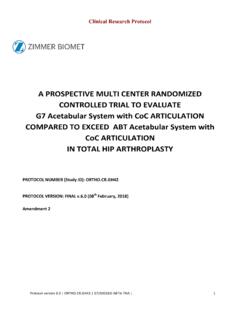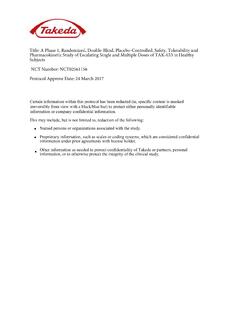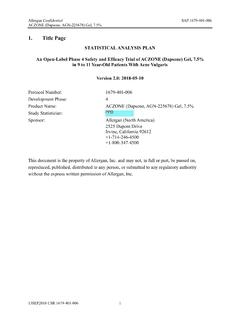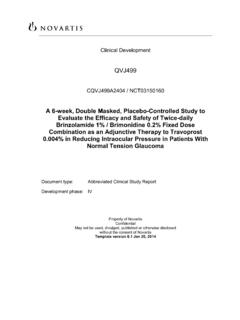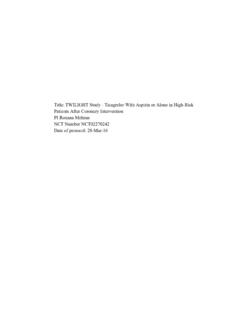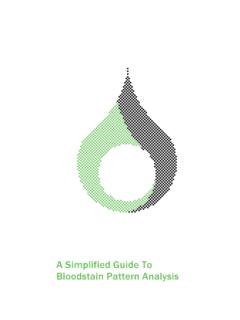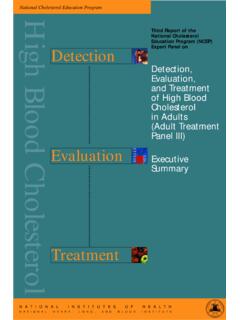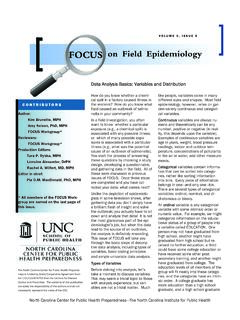Transcription of Statistical Analysis Plan (SAP) - ClinicalTrials.gov
1 Statistical Analysis Plan (SAP) HYDRATION TO OPTIMIZE METABOLISM Principal Investigator Olle Melander, MD, PhD Professor of Internal Medicine Lund University and Sk ne University Hospital Malm , Sweden Protocol identification number H2O Metab Proposal (dated 2017-12-15) identifier 2016894 Author Tommy Schyman, BSc Statistician Clinical Studies Sweden Forum South Sk ne University Hospital Lund, Sweden Version Draft SIGNATURE PAGE Principal Investigator _____ Olle Melander (2017-12-15) Author _____ Tommy Schyman (2017-12-15) Abbreviations ACTH Adrenocorticotrophic hormone CI Confidence Interval DBP Diastolic Blood Pressure eGFR Estimated glomerular filtration rate HbA1c Glycated hemoglobin HDL High Density Lipoprotein IQR Interquartile Range ITT Intention-to-Treat LDL Low Density Lipoprotein OGTT Oral glucose tolerance test OR Odds Ratio PP Per Protocol RCT Randomized Clinical Trial SAP Statistical Analysis Plan SBP Systolic Blood Pressure SD Standard Deviation VP Vasopressin Table of contents 1.
2 Introduction .. 5 2. Study design .. 5 Sample size calculation .. 6 3. Aims and objectives .. 7 4. Outcomes .. 7 Primary outcome .. 7 Secondary outcomes .. 7 Safety outcomes .. 7 5. Populations and subgroups to be analysed .. 8 Populations .. 8 Subgroups .. 8 6. Analyses .. 8 Primary outcome .. 8 Secondary outcomes .. 8 7. Missing data .. 9 1. Introduction The aim of this project is to test in a single-centre randomized clinical trial (RCT), if water supplementation in subjects with high plasma levels of vasopressin (VP) (measured by a stable VP marker of its precursor hormone called copeptin ) can reduce fasting levels of glucose (primary outcome measure), risk of new-onset diabetes and other cardiometabolic risk factors (secondary outcome measures).
3 This Statistical Analysis plan (SAP) will give more detailed descriptions of the endpoints in the study and the corresponding analyses. 2. Study design Study subjects will be recruited from 4 ongoing population studies in the Scania region encompassing altogether approximately 20 000 individuals within the current age span. Copeptin will be measured in -80 degree frozen plasma samples from these 4 studies. Individuals having a copeptin concentration of > pmol/L (women) or > pmol/L (men) will be invited to participate in the screening and inclusion process of this study. If fewer than expected will be recruited from these 4 studies, employees of the City of Malm and Sk ne University Hospital who are 20-75 years will be invited to undergo a fasting plasma determination of copeptin.
4 The same cut-off values will be used for invitation to the study. If more study subjects are needed, a third source of recruitment will be advertisements in local press. The study is a parallel-group RCT with two arms during 12 months. Subjects will be randomized to the water-intervention ( L total in three (3) L increments daily on the top of habitual intake) and control group (1:1). The randomization will be stratified by gender to pursue equal distribution of intervention and control group for both male and female subjects. Both groups will receive general life style advice (general oral and written advice on diet and physical activity).
5 Smart bottles, which are volume sensitive and can be linked to an Android or iPhone application for individual monitoring purposes will be provided to subjects in the active treatment arm. Clinic visits are performed at 8 time points: visit 1, visit 2, baseline, 3 weeks and 3, 6, 9 and 12 months at which cardiometabolic risk factors and hydration parameters are measured. The study design is visualised in Figure 1 below. Figure 1 Flowchart of screening and inclusion process Sample size calculation The primary outcome measure for the power calculation is the difference between active and control treatment in the change of fasting plasma glucose between baseline and 12 months.
6 We use prior effect estimates from the largest RCT for diabetes prevention study in Europe, the Finnish Diabetes Prevention Study (FDPS) (New Engl J Med 2001;344:1343-50), which compared individual life style counselling (active treatment) with general oral and written life-style advice (control treatment) in relation to risk of new onset type 2 diabetes and change of plasma glucose concentration and found a 58% decreased relative risk of diabetes. After 12 months, the fasting glucose in the active treatment group was reduced by 4 12 mg/dL vs a 1 12 mg/dL increase in the control group with the mean difference of 5 mg/dL of the 12-month change of fasting glucose being highly significant (P< ).
7 To obtain sufficient Statistical power to detect a clinically significant effect size, we base our power calculation on an effect of water vs control that is at least 50% of what is considered an epoch changing effect of life style, the difference observed in the FDPS, while assuming the standard deviation for the change (s = mmol/L) as observed in FDPS. In order to be able to detect 50% of that effect (a difference of mg/dL = mmol/L between treatments in 12-month change) we need 319 subjects in both the active and control treatment groups at a power of 80% and a 2-tailed significance level of < Experiences from the WIT (see above) indicate 8-10% lost to follow-up during 12 months.
8 As our study subjects are healthy subjects at risk rather than patients, we anticipate a higher drop-out rate (up to 20%). Based on the power calculation (n=319+319) we will enrol 400 individuals in each treatment group (n=400 in active and n=400 in control arm), a total number of 800 individuals, to have a final sample size robust to lower compliance than anticipated. 3. Aims and objectives To study if water supplementation in subjects with high plasma levels of VP (measured by a stable VP marker of its precursor hormone called copeptin) can reduce fasting levels of glucose, risk of new-onset diabetes and other cardiometabolic risk factors.
9 4. Outcomes This section will present the outcomes investigated to answer the study aims and objectives. The analyses are described in section 6 Analyses. Primary outcome Fasting plasma glucose. It will be measured at baseline, 6 months and 12 months. Secondary outcomes Diabetes incidence New-onset diabetes is defined as 2 consecutive fasting plasma glucose values mmol/L or 2-hour post glucose challenge value of mmol/L at an oral glucose tolerance test (OGTT). In addition, new onset diabetes is considered present if diagnosed by a physician outside of the current study, as assessed in the questionnaire (answering yes on having had a physician diagnosis of diabetes or having been prescribed medication for diabetes).
10 Cardiometabolic risk factors 2-hour glucose during OGTT HbA1c Waist circumference Body mass index Systolic and diastolic blood pressure Serum triglycerides HDL- and LDL-cholesterol Apo-B Apo-A1 Cortisol Adrenocorticotrophic hormone (ACTH) Insulin (fasting and 2h post OGTT) Glucagon (fasting and 2h post OGTT) C-reactive protein Estimated glomerular filtration rate (eGFR) Creatinine clearance All these risk factors will be measured at baseline, 6 months and 12 months. Other blood laboratory parameters Copeptin, Sodium, Potassium, Urea and Erytrocyte Volume Fraction (%). Urine laboratory parameters Volume, Osmolality, Creatinine, Sodium, Potassium, Urea, Albumin/creatinine ratio and Cortisol.



